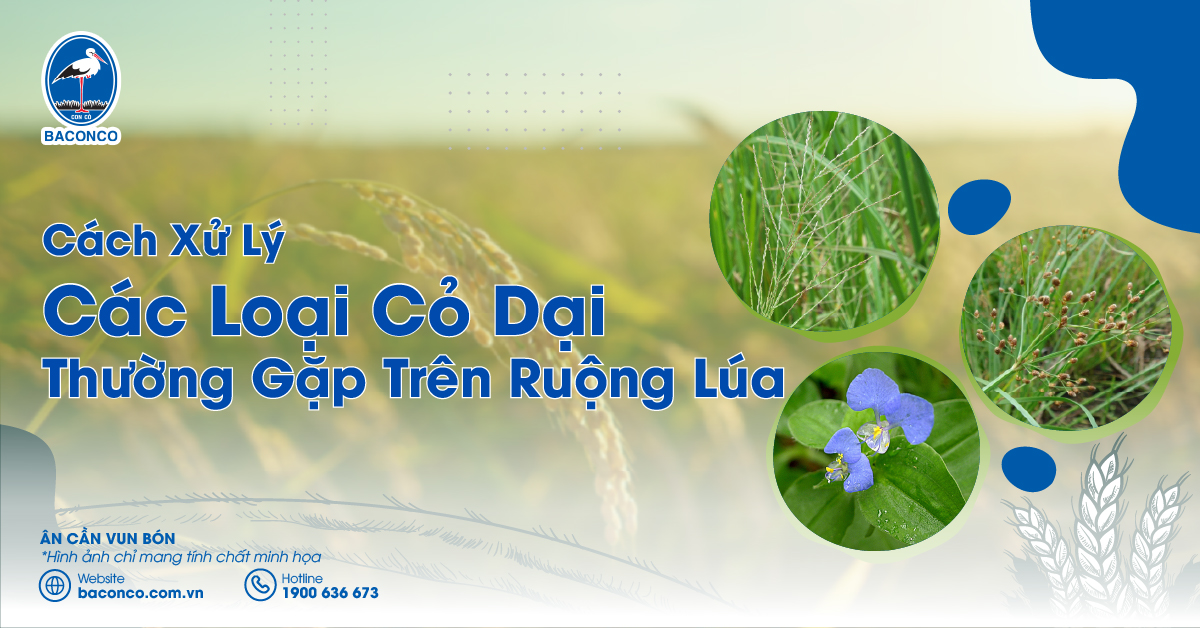How To Handle Common Weeds In Rice Fields
30 Jul 2024

Controlling weeds in rice fields is crucial for successful farming. Farmers cannot produce rice economically without a thorough weed management plan. In this article, Baconco introduces common weeds and how to handle them to help farmers achieve bountiful harvests.
Why is weed control important in rice fields?
Here are some negative impacts of weeds on rice fields:
- Affect rice growth: Weed roots often grow vigorously, occupying the topsoil and competing with rice for nutrients and sunlight, leading to stunted growth and lower yields.
- Harbor diseases: Weeds provide shelter for various pests and diseases such as blast disease, leaf blight, sheath blight, leaf rollers, thrips, etc. These pests can spread rapidly, causing significant damage.
- Increase costs: Due to their robust nature and rapid growth, weeds require farmers to spend considerable time and money on herbicides, tools, and labor for removal.
Rice field with many kinds of weeds
Common weeds in rice fields
Weeds can be classified as follows:
- By growth time:
- Annual weeds: These weeds live for about 1-2 growing seasons and typically die after seeding.
- Perennial weeds: These live for more than a year, often spreading across the ground with strong stems and roots, making them hard to eradicate.
- By shape: Includes broadleaf weeds (dicotyledons) and narrow leaf weeds (monocotyledons).
- By growth characteristics:
- Grassy weeds: Have narrow, long leaves, round, hollow stems, and shallow fibrous roots.
- Sedge weeds: Have narrower leaves than grassy weeds, solid, triangular stems, and spiral leaf arrangements.
- Broadleaf weeds: Have wide leaves, opposite leaf arrangements, and deep taproots.
There are 3 groups of weeds commonly found in rice fields
How to handle weeds in rice fields
Below are common methods for handling weeds in rice fields:
Preventing weeds from entering rice fields
Here are some preventive measures:
- Remove weed seeds: Many weed seeds mature alongside rice and can mix with rice seeds. Ensure seeds are from reputable sources and thoroughly cleaned.
- Clear irrigation canals: Regularly maintain and clear irrigation canals to prevent weeds from spreading through water.
- Field sanitation: Clean fields before planting to prevent weeds from spreading.
- Manure treatment: Treat manure to destroy any weed seeds it may contain before use.
The ditch was cleared and cleaned
Soil preparation
Thorough soil preparation helps eliminate weeds before planting, creating favorable conditions for rice growth. Deep plowing buries weeds, turning them into nutrients for the rice.
Methods of planting
Farmers can use dry, wet, or submerged planting methods based on their conditions. In acidic soils, planting rice submerged in water helps control weeds effectively.
Plant density
Dense planting can suppress weeds but requires more seeds and labor and can increase pest problems. Use suitable planting densities and combine with other methods for better weed control.
Seeds are sown at appropriate density
Water management
Managing water effectively is crucial to control weeds in flooded rice fields. Ensure water levels are high enough to submerge weeds but not rice. Proper water management can reduce weed populations and enhance the effectiveness of other weed control measures.
Timing of weed control
The timing of weed control depends on the type of weeds, rice growth stages, farming practices, and environment. The optimal period for weed control is between 10 and 20 days after planting.
Manual weeding
Manual weeding, though labor-intensive, is widely used and effective. It allows farmers to remove weeds thoroughly and quickly, suitable for organic farming.
Chemical control
Using herbicides is a practical, effective, and economical method. However, herbicides should complement other weed control methods. Choose herbicides that are safe for rice, effective against common weeds, easy to use, and affordable.
A farmer sprays herbicide on rice
Frequently asked questions about weed control
Q1: When is the best time to control weeds?
A: The best time to control weeds is 10-20 days after planting. After 20 days, weed control measures are less effective.
Q2: What are effective weed control methods?
A: Effective weed control methods include:
- Mechanical: Pulling, cutting, and using tarps to block sunlight.
- Chemical: Applying specific, crop-safe herbicides.
- Biological: Introducing insects and animals that feed on weeds.
Farmers should prioritize preventative measures for economic efficiency.
Q3: Can fertilizers be used to control weeds?
A: Yes. Fertilizers like urea and potassium can strengthen plants and help control certain weeds. Mix urea, potassium, and water in a 1:1:10 ratio and spray the solution on weed-infested areas.
Urea and potassium fertilizer solutions can kill weeds
Baconco's herbicides for rice fields
Co-Panil 700EC
Co-Panil 700EC is a selective herbicide for pre- and early post-emergence, combining butachlor and propanil for effective weed control across the three common weed groups.
HERBI RICE
HERBI RICE is effective against grassy, broadleaf, and sedge weeds, suitable for pre- and early post-emergence. Its active ingredients, butachlor and propanil, ensure efficient weed control.
SUPER KOSPHIT
SUPER KOSPHIT is a pre-emergence herbicide containing pretilachlor and fenclorim, effective against most seed-origin weeds and even volunteer rice.
Herbicide products for rice from Baconco
This article provides valuable insights into common weeds in rice fields and effective, economical control methods. Baconco hopes this information helps farmers achieve productive and bountiful harvests.
Views
2827
